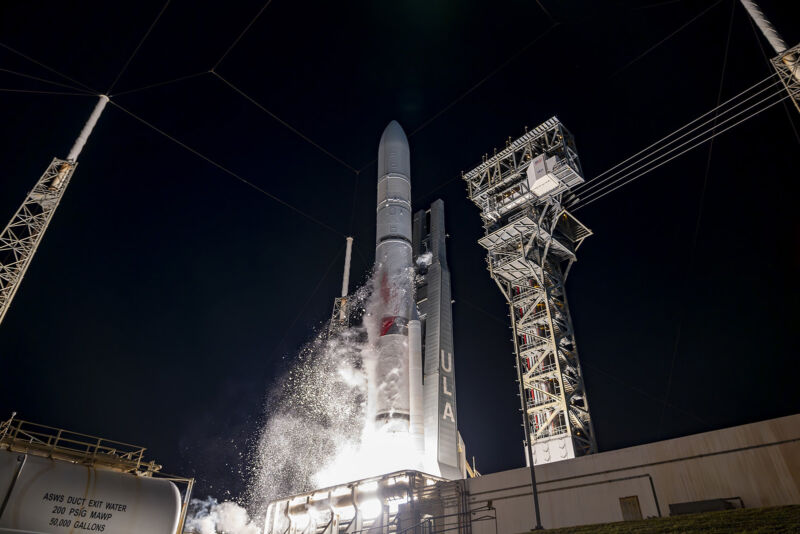LLAP —
United Launch Alliance may seek certification from the Space Force after one flight.

Enlarge / The first Vulcan rocket lifts off from Space Launch Complex 41 at Cape Canaveral Space Force Station.
After the impressive debut of the Vulcan rocket in January, it is unclear when the heavy lift vehicle will fly again. The uncertainty is due to a couple of factors, including the rocket’s readiness and, perhaps more critically, what will fly on top of it.
United Launch Alliance, which assembles and launches the Vulcan rocket, has long maintained that it would launch the Dream Chaser spacecraft for Sierra Space on the rocket’s second mission. This would allow the rocket company to obtain enough data about the performance of Vulcan to earn certification for national security payloads.
An indication of the emphasis the company has put on earning certification from the Space Force—launching military payloads is the primary justification for the existence of Vulcan—comes from the names it chose for the first two launches, Cert-1 and Cert-2.
But what happens if the payload is not ready for Cert-2, as increasingly looks likely to be the case?
Chasing Dreams
After a long development period, Sierra Space’s Dream Chaser vehicle is making credible progress toward the launch pad. It is currently undergoing environmental testing at a NASA facility in Ohio, including vibration tests.
On NASA’s internal schedule for missions to the International Space Station, the Dream Chaser mission to supply cargo to the orbiting laboratory currently has a “planning” date of September. However, this is not a firm date and is subject to slippage.
In fact, there is skepticism within the space agency about a fall launch. According to one source, during a recent meeting to integrate planning for space station activities, there were significant inconsistencies in the schedule that Sierra Space officials laid out for NASA.
It is possible that Dream Chaser will not be ready to launch until 2025, and then its flight will be subject to the space station schedule, which must coordinate arriving crew and cargo vehicles from SpaceX, Northrop Grumman, Boeing, and Russia.
Vulcan wants to fly sooner
United Launch Alliance would very much like to fly the Vulcan rocket sooner, in order to exit the certification phase and begin flying contracted missions for the US Space Force. Immediately after the Cert-1 mission, the launch of an Astrobotic lunar lander on January 8, the company was keeping open the possibility of a spring launch.
The company planned to set aside 60 days to review data from the “Cert-1” certification mission. If the data looked good from that flight, the plan was to move into preparations for the next launch. United Launch Alliance Vice President Gary Wentz said the earliest opportunity to launch the Cert-2 mission was “April-ish.”
As is commonplace in the launch industry, that schedule proved optimistic. However, given that Vulcan appeared to perform very well on its debut launch, a midsummer target seems realistic for the rocket’s readiness. That leaves three or four months to complete production of the core stage, which still lacks engines.
“The pacing item in our supply chain is the BE-4,” United Launch Alliance chief executive Tory Bruno said about Vulcan during a conference call with reporters in March. The BE-4 rocket engines, two of which power Vulcan’s first stage, are manufactured by Blue Origin. “The reason the BE-4 is a little bit behind everyone else is because it took a little bit longer to get it developed and finished. It is now. We have wonderful facilities at the BE-4 factory in Huntsville, which was just built and expanded, they literally doubled their factory size to do this. So they have to catch up now to everyone else in building ahead.”
United Launch Alliance did not respond to a request for comment for this story about the Vulcan rocket’s readiness or a potential shuffling of the launch manifest. A source said the company is willing to wait until September to launch Dream Chaser. But if the vehicle is not ready by then, Vulcan will likely seek out alternatives.
One-flight certification
Two sources said United Launch Alliance had asked Space Systems Command, the Los Angeles-based unit responsible for military access to space, for at least a partial certification of Vulcan based on data from its initial launch. This would potentially allow Vulcan to carry national security payloads on its second flight or perhaps Defense Innovation Unit payloads such as Blue Origin’s DarkSky-1 mission.
A spokesperson for Space Systems Command declined to respond to questions from Ars about an expedited certification process.
Previously, Col. Douglas Pentecost of the Space Force said United Launch Alliance had chosen the Vulcan certification path requiring the least amount of launches: two. By contrast, Blue Origin has agreed to a three-flight certification process, which requires less paperwork. There is also a six-flight option and even a 14-flight option for certification. The latter option essentially means that if your rocket flies 14 times, it earns certification.
Nevertheless, there is a precedent for a single-flight certification. In 2018, the Air Force agreed to certify SpaceX’s Falcon Heavy rocket after its debut launch in February of that year. That decision was controversial enough that it generated a review by the Department of Defense Inspector General, which found that the military had “generally complied” with its procurement rules.
It’s worth noting, however, that the Falcon Heavy did not carry a military payload on its next two flights. The initial certification appears to have been conditional on the success of the next two commercial missions.